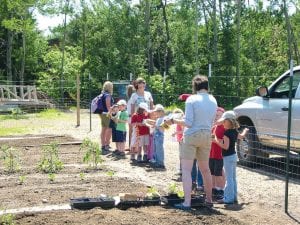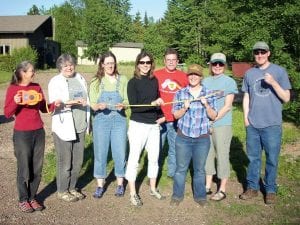What was previously the edge of WTIP Community Radio’s parking lot will sometime this summer become a food source for local residents.
As the nation moves toward greater energy efficiency in tough economic times, some Cook County residents have been thinking about the possibility of growing more food locally instead of importing it. Thanks to a $9,000 grant from the Corporation for Public Broadcasting and the Center for Community Engagement, WTIP and the Northwoods Food Project, another non-profit, have joined forces to turn that possibility into a reality.
WTIP’s grant was awarded to radio stations around the country that were interested in investigating local economic issues. It will help pay for a year-long series called “Living on the Edge: Exploring Economic Reality in Cook County,” which includes a look at local hunger and nutrition issues. It will also be used to help solve a problem for several people who wanted to grow some of their own food but had no garden space of their own.

Left: The Cooperation Station Explorers’ Club is one of five groups growing vegetables in the new community garden at WTIP.
Two years ago, a group of 45 people met to discuss the topic of increasing local food production. The Northwoods Food Project, a 501(c)(3) nonprofit, was formed. One of its goals is to match would-be gardeners with people who have extra garden space.
WTIP’s grant helped pay Edwin E. Thoreson, Inc. to excavate a 20×100′ rectangle. The space was then filled with composted sawdust from Hedstrom Lumber Company and divided into five plots. WTIF Station Manager Deb Benedict said local businesses that have heard of the project have offered parts and labor. Jon and Mary Ofjord donated a truckload of composted horse manure, and Sawtooth Lumber supplied corner posts for the fencing. The Art Colony and local artists will be making stepping stones and hanging artwork designed to keep wildlife away.
Four rain barrels will collect water from WTIP’s roof. Any extra water needed will come from WTIP but will be metered separately by a device donated by the City of Grand Marais that will keep the usual corresponding sewer charges off the bill. “Season extenders” made partly from products found at the Gunflint transfer station and the Recycling Center—plastic encased around loops—will make the short growing season last a little longer. Melinda Spinler of the Northwoods Food Project hopes to someday have a more elaborate watering system with a holding tank.

Above: Workers install a fence that will hopefully keep rabbits and deer from eating the delectable greenery that will be growing through the summer. Even those who will not have a spot in the community garden helped get it ready for its first year of local food production.
Thepeople who had been on the top of Northwoods Food Project’s list of gardening hopefuls were given first dibs on the space. Each garden will be a little different.
Kristine Bottorff and Jan Attridge, known in the Northwoods Food Project as “the squash ladies,” will be growing several varieties of squash. A wide variety of other vegetables such as broccoli, cauliflower, cabbage, and kohlrabi, will be grown by the other gardeners, Amy and David Demmer, Kate Roberts, Jim Zunker, Deb Benedict, and kids from Cooperation Station’s Explorers’ Club and Cook County Extension’s youth gardening program headed by Diane Booth.
The Extension gardeners, who will focus more on root crops and plants that are harvested in the fall such as potatoes, squash, onions, and carrots, will be donating some of their crop to the Art Colony’s Empty Bowls project, a (pretty much) annual soup supper that benefits the local Food Shelf.
“A community garden beautifies an area,” said Spinler. A seasoned gardener, she said that some plants, such as spinach, lettuce, and onions, actually thrive in the cool climate of northern Minnesota. Growing peppers, corn, and tomatoes is questionable, however. She said the Northwoods Food Project encourages the use of natural fertilizers, such as manure, and natural insecticides, such as “beneficial” insects.
Spinler has a passion for growing food in the Northland. She would like to see the Northwoods Food Project revive the use of some heirloom plants that did well here in the past and even develop hybrid plants that would adapt especially well to this climate. The group’s original dream was to buy a small farm, she said. “We are losing a lot of our old homes and farmsteads. Those guys worked really hard to create open space. My dream is to try to preserve some of those areas.”
Twelve to 18 people are still hoping to find gardening space within the community, Spinler said.
Meanwhile, WTIP News Director Barbara Jean Meyers continues to broadcast features on the county’s economy, including its food issues. Some people are concerned about how far food must travel to get to Cook County, Meyers said, and how much it costs to transport it.
According to Meyers, the county has seen a large increase in the number of people utilizing food programs. The food shelf is serving 20-30% more people than it did last year, and 1/3 of those who benefit from it are children. Thirty-three percent of the county’s school children are on the federal free and reduced lunch program, and 95% of the county’s pregnant women qualify for WIC (Women, Infants, and Children, another federal program that provides staple items). Meyers believes “a significant need” exists in Cook County.
WTIP’s Living on the Edge series can be found online at www.wtip.org/livingontheedge. html. The station plans to introduce the topic of local food needs and local food production to Cook County Conversations, an online discussion group located at http:// forums.e-democracy.org/groups/cc, in August.



Loading Comments